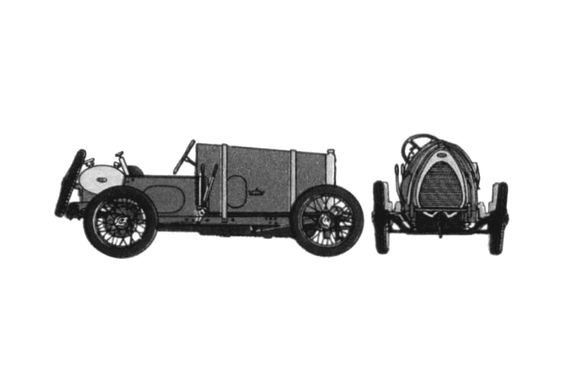
Bugatti Type 13 Brescia OW 1913
- jpg
Specifications Bugatti Type 13 Brescia OW 1913 blueprint
The Bugatti Type 13 Brescia OW 1913 was a significant early model in the French luxury automotive company's long and storied history. This spectacular classic car of the Roaring Twenties was released in 1913 and was the very first production model of the Bugatti range, with only 25 being built and sold. It has become an iconic symbol of the brand and universally recognized as a work of art. The Type 13 Brescia is a two-seater sports car that was designed to be driven in both road and track events. It features a 3.3 litre, four cylinder engine with two lower flange bodies, and is mated to a four-speed manual transmission. Performance was monumentous for the vintage, as the Brescia had the ability to reach speeds in excess of 80 MPH and an impressive 80 horsepower. It was also exceptionally light, weighing in at just 1,400 pounds (635 kg). The Type 13 was designed and unveiled in the illustrious Molsheim workshop in Alsace, and is recognized now as the very first express car which truly achieved impactful success on the racing circuit. Its classic chassis was constructed with a large rear differential housing and a boxed-in frame with distinctive Bugatti style trim on each side. Externally, its body is distinctive for its elongated bonnet, angled hood and symmetrical fenders which span over both the left and right side of the frame. It also features a split windshield and six diamond-shaped vents at the front, as well as a horse-drawn carriage-style wood-spoke steering wheel. Overall, the Bugatti Type 13 Brescia is a timeless classic that serves as a testament to the brand's longstanding commitment to quality and craftsmanship. Its performance on the track, durability and aesthetic appeal have made it a much sought-after vintage car that stands as a leader in the world of motoring.

Careful measurement of the actual dimensions of the models, when creating their sketches, guarantees the high accuracy of our drawings, which is at the level of 94% - 99%.

When creating working drawings, all proportions of the depicted objects are strictly maintained.

You no longer need to create individual drawings of parts from scratch. The required changes to existing works are easily made using graphic editors.

The copyright holder permits the use of ready-made drawings, acquired under a free license, in the development of projects, scientific works and the preparation of presentations.


